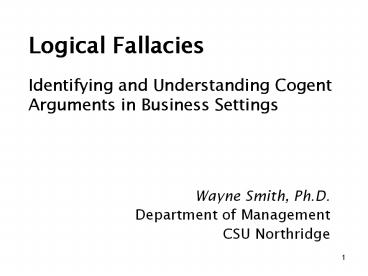Logical Fallacies - PowerPoint PPT Presentation
Title:
Logical Fallacies
Description:
Logical Fallacies Identifying and Understanding Cogent Arguments in Business Settings Wayne Smith, Ph.D. Department of Management CSU Northridge – PowerPoint PPT presentation
Number of Views:244
Avg rating:3.0/5.0
Title: Logical Fallacies
1
Logical Fallacies
Identifying and Understanding Cogent Arguments in
Business Settings
- Wayne Smith, Ph.D.
- Department of Management
- CSU Northridge
2
Informal Fallacies
- Individuals make arguments, and not all arguments
are valid. - This invalidity is due to false premises.
- Individuals also commit fallacies, and such
fallacies are the result of incorrect or weak
reasoning. - We will focus on the latter, and refer to the
former as needed. - The text that follows uses the terms arguer and
reader. However, the terms speaker and
listener, respectively, can be substituted as
appropriate.
3
Fallacies of Reference
Fallacies of Reference have arguments that
contain premises from which the conclusion does
not flow logically.
4
Appeal to Force
- This fallacy occurs when an arguer poses a
conclusion to a reader, and the reader is
compelled to accept the conclusion only under a
physical or psychological threat made by the
arguer.
5
Appeal to Pity
- This fallacy occurs when an arguer attempts to
support a conclusion by merely evoking pity from
the reader.
6
Appeal to the People
- This fallacy occurs when an arguer uses desires
(e.g., love, esteem, admiration, value,
recognition, etc.) to get the reader to accept a
conclusion. - Direct Approach
- Directed to an entire group
- Indirect Approach
- Directed to an individual that represents the
groups values - Variations
- Bandwagon Argument
- Appeal to Vanity
- Appeal to Snobbery
7
Argument Against the Person
- This fallacy always involves two arguers. It
occurs when an arguer advances a certain
argument, and the other then responds by
directing his or her attention not to the first
persons argument, but rather to the first person
himself/herself. - Variations
- Abusive
- Circumstantial
- tu quoque (you too)
8
Accident
- The fallacy of accident is committed when a
general rule is applied to a specific case it was
not intended to cover. - Typically, the general rule is cited in the
premises and then wrongly applied to the specific
case.
9
Straw Man
- This fallacy occurs is committed when an arguer
distorts an opponents argument for the purpose
of more easily attacking it, demolishes the
distorted argument, and then concludes that the
opponents real argument has been demolished.
10
Missing the Point
- Missing the point is a special form of
irrelevance. - This fallacy occurs when the premises of an
argument support one particular conclusion, but
then a different conclusion, often vaguely
related to the correct conclusion, is drawn.
11
Red Herring
- This fallacy occurs when an arguer diverts the
attention of the reader by changing the subject
to a different but sometimes subtly related one.
By doing so, the arguer purports to have won the
argument.
12
Fallacies of Weak Induction
Fallacies of Weak Induction occur because the
connection between premises and conclusion is not
strong enough to support the conclusion.
13
Appeal to Unqualified Authority
- This fallacy occurs when an arguer uses a
citation that lacks credibility.
14
Appeal to Ignorance
- This fallacy occurs when the premises of an
argument state that nothing has been proved one
way or the other about something, and the
conclusion then makes a definite assertion about
that thing.
15
Hasty Generalization (Converse Accident)
- This fallacy occurs when there is a reasonable
likelihood that a sample is not representative of
the group. Such a likelihood may arise if the
sample is either too small or not randomly
selected.
16
False Cause
- The fallacy of false cause occurs whenever the
link between premises and conclusion depends on
some imagined causal connection that probably
does not exist.
17
Slippery Slope
- This fallacy is a variation of the false cause
fallacy. It occurs when the conclusion of an
argument rests upon an alleged chain reaction and
there is not sufficient reason to think that the
chain reaction will actually take place.
18
Weak Analogy
- The fallacy of weak analogy is committed when the
analogy is not strong enough to support the
conclusion that is drawn.
19
Fallacies of Presumption, Ambiguity, and
Grammatical Analogy
20
Begging the Question
- The fallacy of begging the question occurs
whenever the arguer creates the illusion that
inadequate premises provide adequate support for
the conclusion by leaving out a possibly false
(or shaky) key premise.
21
Complex Question
- This fallacy is committed when two or more
questions are asked in the guise of a single
question and a single answer is then given to
both of them.
22
Suppressed Evidence
- This fallacy occurs when an argument ignores some
important piece of evidence that outweighs the
presented evidence and entails a very different
conclusion.
23
Equivocation
- This fallacy occurs when the conclusion of an
argument depends on the fact that a word or
phrase is uses, either explicitly or implicitly,
in two different senses in the argument. - Such arguments are either invalid or have a false
premise, and in either case they are unsound.
24
Amphiboly
- The fallacy of amphiboly occurs when the arguer
misinterprets an ambiguous statement and then
draws a conclusion based on this faulty
interpretation. - Often, this fallacy arises from a mistake in
grammar or punctuation.
25
Composition
- The fallacy of composition is committed when the
conclusion of an argument depends on the
erroneous transference of an attribute from the
parts of something onto the whole.
26
Division
- The fallacy is committed when the conclusion of
an argument depends on the erroneous transference
of an attribute from a whole (or a class) onto
its parts (or members). - This fallacy occurs is exact reverse of
composition.
27
Sources
- Hurley, P. (2006), A Concise Introduction to
Logic, 9th ed., AustraliaThompson.































